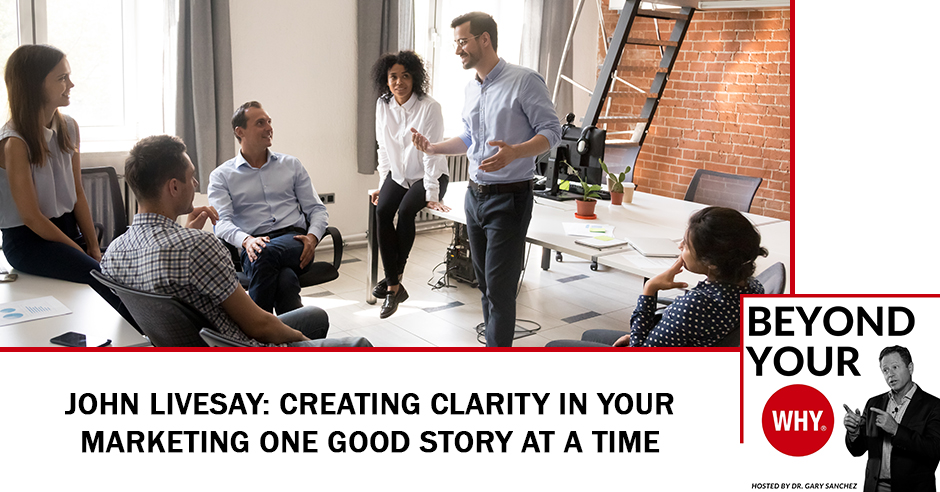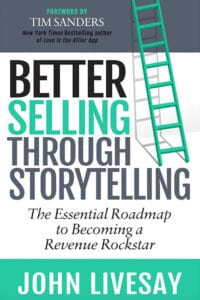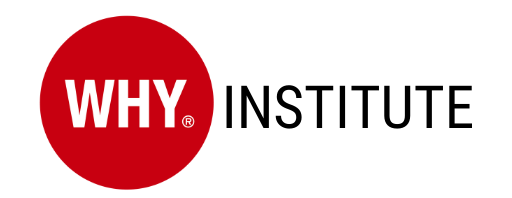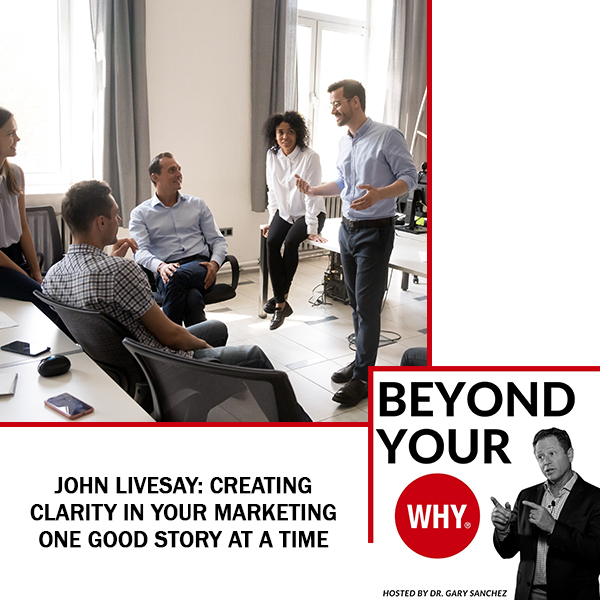
John Livesay understands the power of compelling storytelling, harnessing it for marketing purposes and connecting well with people. His “why of clarify” shows up in the way he writes narratives where the audience can see themselves in the characters involved, creating clarity in the message he wants to convey.
Join Dr. Gary Sanchez as he talks with John on how these excellent marketing materials that rely on value rather than cost can serve as significant breakthroughs in the world of advertising. Listen to this informative conversation as John unravels the right ingredients that make up a good story, how reverse engineering plays a role in this process, and the best strategies in conducting a truly engaging presentation.
See acast.com/privacy for privacy and opt-out information.
—
Watch the episode here:
Listen to the podcast here:
John Livesay: Creating Clarity In Your Marketing One Good Story At A Time
If you’re a regular reader, you know that we talk about 1 of the 9 whys and then we bring on somebody with that why so we can see how their why has played out in their life. We’re going to be talking about the why of clarify. If this is your why, then you are a master in communication. You seek to be fully understood at all times. It is important for you to know that people get what you are saying and you generally employ numerous methods to express a given point. You will use analogies and metaphors to share your views in interesting and unique manners that share your why often suffered in a dysfunctional communication environment during their upbringing and seek to make up for that with extraordinary clarity both spoken and written. You feel successful when you know with confidence that your message has been fully understood and received and have tremendous command over language generally superior to most.
I’ve got a great guest for you. His name is John Livesay, also known as, The Pitch Whisperer. He is a sales keynote speaker where he shows companies how to turn mundane case studies into compelling case stories, so they will win more new business. From John’s award-winning career at Conde Nast, he shares the lessons he learned that turned sales teams into revenue rockstars. His TEDx Talk, Be The Lifeguard of Your Own Life! has over one million views. Clients love working with John because of his ongoing support after his talk, which includes implementing the storytelling skills from his bestselling book and online course, Better Selling Through Storytelling. His book is now required reading for the UTLA University of Texas in LA course on Entertainment and Media Studies. He is also the host of The Successful Pitch podcast, which has been heard in over 60 countries. John, welcome to the show.
Gary, thanks for having me.
[bctt tweet=”Advertising is the ultimate combination of show business. ” username=”whyinstitute”]
I’ve been excited about this because you and I talked before and I was telling you that I’ve heard a lot of people say they’re good storytellers and how to use stories. You do it at a different level, so I’m excited about this. Give us your life story. Where’d you go to school and how did you get into storytelling?
I went to school at the University of Illinois in Champaign-Urbana and got a degree in Advertising, which is the ultimate combination of showbusiness and business. I was always fascinated by how something motivates somebody and how does somebody remembers a jingle from a commercial. All that fascinated me. That was always of interest to me. I found advertising fascinating. I took a trip around the world after school, came back, and decided, “I want to get into the tech world.” I got a job selling these multimillion-dollar computers competing against IBM, living in San Francisco, and getting involved in Silicon Valley. I realized that even if you had something less expensive and more reliable and faster, people still wouldn’t buy it. If IBM was putting fear, uncertainty, and doubt in their head that if something broke and it was your equipment, you would get fired for bringing it in.
I had to understand the psychology underneath people’s decision-making. I then moved to LA and got a job at an ad agency where my job was to sell that agency services to create movies for commercials. You’d watch a commercial to rent a movie at Blockbuster back when that was happening. That’s where I got to hone my storytelling skills because if a movie had come out theatrically and not done well, it’s almost like a second chance for the studio to have the home video division to tell the agency, “Let’s create a different commercial and reposition this movie in 30 seconds to get people to want to go rent or buy it.” That was a lot of fun. I’m still selling and then I had a fifteen-year sales career at Conde Nast selling to brands like Lexus, Guess jeans, the Banana Republic, and Nike. It was all about how do you convince them or all the choices they have to run their ads in a particular magazine.
It was always about whoever told the best story got the sale. That’s why I’m able to speak to sales teams because I’ve been in their shoes. I had quotas, trying to beat your numbers, competing against other people, and trying to differentiate yourself every time. For the last several years, I’ve been helping salespeople get off what I call the self-esteem rollercoaster because I was on it and it’s miserable. You only feel good about yourself if your numbers are up and things are going great and bad if they’re not. When we can zoom out and realize that our identity is bigger than any one thing happening to us, whether it’s losing a job like I got laid off or winning a sales award as I did a couple of years later, we are free from that rollercoaster.
What was that incident when you noticed that stories sell? What happened?
For me personally, it was the first time I had to sell myself to get a job at Conde Nast. We often sell ourselves all the time, even if we’re not in that “position” to get hired or promoted. They put you through many interviews there. There’s a lot of competition. When it got to the 3rd and 4th interview, and I was talking to HR, and it had been very clear that this was an expensive ad magazine to run it and you had to convince people to pay a premium, I was saying to them, “You want to have somebody who can do that, and yet you only want to pay this. If I can’t convince you to pay me what my salary requirements are even if it’s above what your budget is, then I wouldn’t be good at selling your magazine?” They then went, “Oh.”

I said, “It reminds me of when you go looking for a house and you have your dream list, ‘I want a view, the pool, in a great neighborhood, and I only have this budget.’” A lot of times, you have to give up one of those three things to fit your budget. I said, “I need a house with the pool, the view and the location. Location-wise, I know the territory, the view I can get not only the obvious clients to advertise but non-obvious clients. As far as hitting the ground running, that’s what I offer. If you don’t have the budget to have that, then you might have to give something up and hire another candidate that doesn’t bring all of that.” That’s what allowed me to use storytelling to get myself hired the first time.
From then forward, you started using storytelling in selling product for their advertising agency and got better and better at it.
One of the clients I was able to convince to advertise with me at the time when I was selling a high fashion magazine called W was understanding their problem. Jaguar had said, “We want people to think of our cars as moving sculpture, but we have no idea how to make that happen.” I worked with the marketing team and came up with a story of how we would have ten couples that have the income level. We can even slice it down to people who have a competitive car lease coming up within six months and get picked up in a new Jaguar, taken to our Golden Globes party, and then from there, to a private dinner at a private dining room with the chef.
Some people from the Museum of Modern Art would be speaking about art and a Jaguar representative could be there. In between courses, people could take another test driver on the block in another car. They loved that idea. It worked so well that I got ten pages of advertising, which was $500,000. They sold two cars that night. They’ve felt like they were part of the conversation because the Museum of Art was talking about what sculpture and art are, and then someone from Jaguar would say, “That inspired our design of this.”
What makes a good story? How do you help somebody? If I’m reading and I think, “I’ve got a great product. I’ve got great service. I’m talented in these different areas.” How do I create a story that helps me to sell? What makes up a great story?
[bctt tweet=”The better you describe a problem, the more people will think you have their solution. ” username=”whyinstitute”]
A good story has four parts. The first part is the exposition. You’ve got to think of yourself like a journalist. The who, what, where, when, all of that is to paint the picture so that people see themselves in the story. The second part of the story is the problem. The better you described the problem, the more people think you have their solution. In any good story, the stakes are pretty high. That makes us lean in and wonder. We have to care about the hero of the story. By the way, you’re not the hero of the story, your client is, and you’re the Sherpa. You then present your solution and the magic sauce to any great story is the resolution. Most people don’t have that.
What happens to this person after they bought your product? Imagine if The Wizard of Oz ended where Dorothy getting in the balloon and going back to Kansas? There wasn’t that wonderful resolution scene where she’s in bed going, “There’s no place like home. You were there. I learned so much about myself, and what matters.” That’s why that movie and that story is so classic. When I can work with people on having all four of those elements in their case stories instead of case studies, then they are memorable, and they’re tugging at people’s heartstrings, and then people want to open the purse strings.
Let’s come up with an example. Let’s say I’m an entrepreneur. How could we get our audience to understand and feel this? What would be a good example to share with them?
I can give you a real-life example of Olympus Medical. The camera company has a medical division using their camera technology to create equipment. I was working with their team, and I said, “What are you saying now to doctors to get them to buy this equipment?” They said, “It makes the surgeries go 30% faster. Do you want one?” I said, “That’s left brain, numbers, speeds, and feeds. We used to call it the tech biz, pushing out information. We need to craft a story because people buy emotionally, not logically, not with numbers.” The exposition in that is here’s the story that they’re not telling. “Imagine how happy Dr. Higgins was down at Long Beach Memorial using our equipment and he could go out to the patient’s family in the waiting room an hour earlier than expected.”
If you’ve ever waited for somebody you love to come out of surgery, you know every minute feels like an hour. He came out and put them out of their waiting misery and said, “Good news. The scope shows they don’t have cancer. They’re going to be fine.” The doc turns to the rep and says, “That’s why I became a doctor, for moments like this.” That salesperson has a case story that they tell to another doctor at another hospital who sees themselves in that story and says, “That’s why I became a doctor too. I want your equipment.” It’s very different.
When I worked with Olympus, they are like, “This gives us chills. Not only are we not telling stories that never occurred to us to put the patient’s family as a character in the story.” You’ll see how I used the technique of pulling you in by saying, “If you’ve ever waited for someone you love to come out of surgery.” Even if you haven’t, you probably know somebody who had to do that. We’re tapping into your whole sweet spot, the doctor’s why. It’s in the resolution of that story. Without that resolution, the patient was fine and the doctor came out an hour earlier. The resolution is what pulls people in.
When you’re helping them to craft their story, do you break it down piece by piece like you did before, “Let’s develop this, and then we put it all together?”

It’s a step-by-step process. I get to work with them and saying, “That resolution could be stronger.” The problem, we could have a little more emotion in that and get the stakes a little higher. It’s a fine-tuning process to get it clear, concise, and compelling. That’s my checklist. We got to make sure it’s doing all three before we put it out into the world.
Which goes right along with clarify, you’re using stories to make things clear so that people can make a decision to move in the direction that you want them to go.
The first time I heard that the confused mind always says, no, that was a huge light bulb for me. I was like, “That makes perfect sense to me.” For me, that’s my why of clarification. That’s why the stakes are so high if I’m not clear, and if I’m not teaching other people to be clear, then no one’s ever going to tell you that they’re confused. They just won’t buy. Their ego won’t let them. You’re using acronyms they don’t understand. Even as a dentist with a patient, you start describing some procedure, and they’re like, “I don’t understand that, but I’m going to pass. Thanks, anyway. I don’t need that.” It’s too confusing.
If you say, “Here’s what happens when if you don’t get this root canal, crown, or implant,” then they go, “I don’t want that.” For example, when I was working out with my trainer, he was like, “We’re going to do deadlifts.” I’m like, “Do we have to? Who cares what the back of my legs looks like?” He goes, “Have you ever been in the shower and seen an old guy with a saggy butt?” I’m like, “Yes.” He goes, “That’s because they don’t have strong hamstrings to hold it up.” I’m like, “How many do you want me to do? I’m totally in now.” I don’t want to be that guy. That’s what I mean about painting the picture of what the stakes are if you don’t do something.
What advice do you give to people? I’m thinking myself here. I would love to tell more stories, but in the heat of the moment, I feel like I answered the question.
That is a behavior we’ve learned. I have two parts to this answer. The first part is confident people are comfortable with silence. Just because somebody asks you a question, it doesn’t mean you have to jump into your normal response of, “Let me answer that question for you.” You can take a breath. You can take a few seconds and remember, “I want to tell a story to answer your question.” Even if you have to use that transition statement, they’d ask you a question, “Let me tell you a story that’s going to answer your question.” It makes sense why you’re telling me a story. You’ve given me a reason to listen, and then you go into it. My real tip on becoming a better listener is after you’ve answered the question, ask somebody, did that answer your question?
[bctt tweet=”Confident people are comfortable with silence. ” username=”whyinstitute”]
You’d be surprised how people will say, “Yes, it did. It did, but now I have another question.” You want to have the dialogue going. The willingness to, “I’ve answered that. I’m done. Back to my presentation.” No. If I wasn’t clear, that’s my responsibility. I didn’t answer your question. You don’t want to be seen as a politician that avoids questions, telling a story. Is that the answer you were looking for? When you make people feel seen and heard, they feel appreciated, and they’re on your side. That’s the trust-building and the core of getting a relationship going in any situation.
Why are stories effective?
It’s literally in our DNA. If you think back to the days when we all lived in caves, there were stories on the walls. People would sit around campfires and tell stories. It’s how legacies get passed down. When you tell someone a story, their brain goes, “This might be entertaining, or at least interesting, hopefully. They’re not data that I have to analyze.” We’re shifting out of, “Let me see if this is something I agree with or disagree with,” to “I’m in the story. I’m taking on a journey.” It taps into a different way of thinking. The biggest problem itself is being forgettable. If you push out facts and figures and you hang up or leave the room or the Zoom and like, “I don’t remember what that guy said about the WHY Institute.”
If you tell a story of how somebody discovered their why and started teaching their team how to discover their why and how now, it’s the foundation to their whole success, then they are remembering that story and repeating it to other people, because everybody wants to be brought up in that second meeting. You and your team, you go present to pitch something to a potential client, and they’re looking at maybe a competitor or two, and then they have the second meeting where they say, “We heard three pitches. Which one does anybody like or remember?”
If nobody remembers anything, it’s just a bunch of numbers, we should go with the cheapest solution. If someone sold a story of a coach that suddenly figured out their own why and help their clients figure out their why much faster, much more accurately, and how that coaching business took off because the results the clients were getting, because the foundation of the why was there, that’s the story that people are saying, “You got to get the why first before you started anything else. It’s like building a house without foundation.”
I wonder if that’s why podcasts have become popular now. We get to talk to people and hear their stories instead of what they did or the facts, figures, and features. We get to talk about what’s the story behind that. Instead of you being somebody who learned how to tell a story, you had a reason to have to learn how to tell stories, which opened all that whole world up for you.
People crave stories. In fact, some of the most popular podcasts are those serialized things that used to be old-school television shows and still exist on Netflix, where we binge-watch. Why do we binge-watch? If they have a cliffhanger at the end or an open loop in a story, “I’ll watch the first five minutes to find out if that person died or not.” That’s what keeps us engaged emotionally. A good podcast will do that because you’re being informed and entertained and hopefully inspired. If you’re hitting all three of those buttons in your stories and in your podcast that keeps people coming back. That’s the sticky factor that advertising is all about.
Tell us about Be The Lifeguard of Your Own Life! That was your TEDx Talk. What was that all about?
I literally was a lifeguard. I want to emphasize the fact that when you tell the story, make sure it’s authentic. I have some credibility talking about being a lifeguard. One of the lessons I learned all those many years ago was don’t panic and stay calm when someone is drowning. You’ve got to rely on your training. I have a special effect about that even. I had to jump in and save a little girl who was twelve years old. She dived off the high dive for the first time and she was underwater two seconds too long. I had to pull her out and stay calm myself. That lesson of not panicking and staying calm served me my whole career, including when I got laid off from Conde Nast back in 2008, and everyone else was storming out and angry.
I said to the publisher, “Don’t you want a status report to know where these ads should be running down the road in which page numbers?” That’d be great, but everyone else is angry. They’re leaving. I said, “I’m not going to do that to the clients. My training from not panicking and staying calm during a stressful situation like that where I had to be out on the same day is what allowed me to get rehired back two years later and win salesperson of the year.” I was the only one that left on a good note. We’re all being with the pandemic. It’s not the last time we’re going to be disrupted in our lives and this ability to not panic and stay calm as opposed to, “It’s a hurricane. I don’t have to evacuate. Someone’s going to send a helicopter if things get bad.” No, we all have to be our own lifeguards.
You took all you’ve learned, and you put it into your book. Tell us about the book Better Selling Through Storytelling.
People have asked me to not only have it as a book but also as an online course. After I’ve been speaking to teams or if people want to work with me, the course and the book all work together on teaching you how to become a black belt in storytelling. We cover the mindset of how important it is to what story you’re telling yourself, which is what your work is all about, and then how to tell a story that gets you out of the friend zone at work. Almost everyone I’ve ever worked with, we all know what the friend zone is in the dating world. Most of us mortals have been stuck in the friend zone in our dating life. As a salesperson, you go, “I’m interested. Send some information,” and it’s crickets. I show people how to get out of that friend zone at work where people say they’re interested, but they’re not intrigued enough. I go from getting people from, “I’m interested” to “I’m in.” Storytelling is that bridge.
Give us an example of that. Take us through that particular scenario where somebody says, “I’m interested,” and crickets, versus, “Yes, I’m in.”
The premise is if you’ve said something interesting, for example, when I was calling on Speedo to get them to advertise with me. I said to them, “Would you advertise that in my fashion magazine?” They said, “No, we’re going into fitness magazine.” I used part of my training is what if. You start a sentence with what if? It gets you on the right side of the imagination and storytelling. I start to paint a picture. I said, “What if we did something unexpected with your sportswear line and treated it like it was high fashion. We could have the models wearing your sportswear around a swimming pool at a hotel. Since Michael Phelps is on your payroll during the Olympics, you could invite him, and we get all kinds of press.” They were no longer went from no to, “We’re interested. How would that work?” Now, we’re into intriguing. I paint the picture a little bit more. It became such an irresistible idea that they went from, “We’re not running in a fashion magazine,” to “This is going to get us a lot more press and sales and publicity.” I got the sale. More importantly for me personally, as a former lifeguard, I got to meet Michael Phelps. That’s a whole another story of what lessons I learned that I could pass on now.
Before you do that, it’s like you were taking us through a few steps there. What were those steps?

First of all, you’re invisible. Let’s say Speedo never thought of a fashion magazine even on their radar. It’s invisible. It’s my job to be on their radar. You then move up to insignificant. In the dating world, I don’t know what’s worse, invisible or insignificant. I was at the insignificant rung. They’re like, “We’re running in fitness. It’s insignificant to us for us to be in fashion. No one thinks of this as fashion.” I had to come up with the idea that it was interesting enough for them to at least take a meeting and then paint the picture to get them up to intriguing and then flush all the details out about, “Which hotel, which pool, which press would be invited?” The details of getting Michael Phelps there and working with them to make that happen, which was the linchpin to the idea, all is what took that up to the irresistible level.
Irresistible then becomes decision, “I got to make it happen.”
I’m interested so I’m in. In the dating world, “We can stop thinking about you. We text you all the time.” In this case, “We’re excited for this event.”
Does every decision go through those stages or does every sale goes through those stages?
It does. The old way of selling, I had to do it for decades. We would do projections. How many people are at 90%, 50%, or 20%? You do the Math, and then you’d give a number of, “I can make this many sales this month, this quarter, this year.” Nobody thinks of themselves as a percentage. I created this ladder to put our empathy hat on so that we see ourselves through the client’s eyes. Where are we on the ladder? Are we invisible? Are we stuck interesting? Are we intriguing? Do we have clients that love us, but we’re not paying enough attention to them? You know as well as I do that any relationship that’s not nurtured goes away.
I know what you’re talking about because we use HubSpot. In HubSpot, there are different levels of where the sale is but I don’t really understand them very well. “How do you know I’m at 20%, 40%, or 70%? Where did you come up with that?” What you’re talking about gives me the next phase to shoot for and what that means.
It’s a roadmap for everyone I work with of how they look at their clients. They have these dream clients that they’re invisible and they’re afraid to reach out to and like, “Let’s collaborate and then let’s create some stories to get you up each rung of the ladder.” Most of us mortals, if we’re having a coffee date with somebody, we don’t ask them to get married, yet a lot of people are reaching to people on LinkedIn going, “Do you want to buy?” You got to figure out where you are on the ladder to move up.
Tell us about Michael Phelps.
On the day of the event, the fashion show is going great. He couldn’t have been nicer. I’m a total fan. I walked up to him and I said, “Michael, everyone says you’re successful because your feet are like fins and your lung capacity is bigger than the average person, but I’m guessing there’s something else that makes you an Olympic champion.” He goes, “Yes, John. When I was younger, my coach said to me, ‘Michael, are you willing to work out on Sundays?’ I said, ‘Yes, coach.’ He said, ‘We got 52 more workouts in a year than the competition.’” I said, “Thanks, Michael.” When I give that story to audiences, I ask them, “What are you willing to do that your competition isn’t to get to the Olympic level. What are you willing to do that they maybe even haven’t thought to do?” That leads to another story. That’s how I interweave storytelling with takeaways.
I had a coach named Alan Stein on the show. He was doing some work with Kobe Bryant. He said that Kobe would come in at 4:00 in the morning and work out at 9:00 and then work out at 12:00. Where everybody else was working out two times a day, he was working out three times a day so that gave him the same thing. He said, “I’m gaining on my competition to the point where soon they’ll never be able to catch me.”
I don’t know if you noticed when I was telling that Michael Phelps’s story. This is a tip for everyone who wants to be a better storyteller, tell your story in the present tense. I spoke it like it was live dialogue, like you were eavesdropping in on the conversation. Instead of saying, “When I asked Michael why he’s so successful, he told me his coach said work out on Sundays.” I acted it out for you with different voices, looking down, looking up. “Yes, coach.” That’s the difference between telling a good story versus reading something.
Instead of talking about it, it’s bringing me into it. What other tips you got for us? I’m speaking at an event. Now I got to use all these things. I won’t do as good a job as you will, but I’ll pick up a little bit.
If you’re giving a talk or you’re giving a sales pitch, whatever it is, my big suggestion is to reverse engineer it. For my left-brain friends, I don’t know why that is out of the nine but I’m sure there’s a lot of them. The logic people love that, “Reverse engineer something? I’m in.” That’s how I pull them in. I’m like, “Let’s reverse engineer this.” You ask yourself these three questions, “What do I want the audience to think, feel or do?” When you have the answers to those three questions, you now have the end of your talk, the end of your pitch, and then you go, “What’s my opening?” You structure the rest of your talk from there. You want them to do all of those things, not just one.
I’ve seen many people make presentations go, “That’s all we got. Any questions?” As opposed to, “Let’s sum up the potential journey we could go on together to renovate this airport and make people feel proud to live in the city who are returning home and give people a wow factor who’ve never been here before and reframe their concept of what Pittsburgh looks like.” We’re the perfect team to make you do this. A lot of us have lived here our whole life. This isn’t another job for us. This is the hometown game. I helped Gensler Craft when they won a billion-dollar airport renovation of the Pittsburgh Airport against two other firms.
Tell us about that.
They were told, “You’re in the final three. You can all do the work or you wouldn’t be in the final three. You have an hour to come in and tell us why. Part of the criteria was likeability because we’ve got to work with you for six years.” That’s when they pulled me in. They said, “We usually show our designs and hope that’s enough to win the business. We don’t even know where to start.” I said, “Let’s start with the team slide.” This is part of what I teach in the course and working with people, your story of origin. I said, “What are you going to say?” “My name is Bob. I’ve been here ten years.”
I’m like, “No. Bob, what made you become an architect?” “I was eleven years old. I play with Legos. Now I have a son that’s eleven and I still play with Legos with him. I have that same passion.” “Where were you before here?” “The Israeli Army.” “You learned about focus and discipline. Since you’re in charge of making sure this thing comes on time and under budget, you’re the perfect background.” I pulled out little individual stories of each of them that made them memorable and likable. The other two firms did the traditional, “This is what I do.”
When it came time for the presentation, do you think they thought more about the facts, figures, and features or the feelings?
The feelings. I was with them for two days prepping for that one hour to win because the stakes were high. From what they’re saying at the opening, at the ending, on the team side, to turning those before and after pictures of other airports into a story, the storytelling became the whole framework for the whole hour.
You brought up something else that is a struggle for me. I’m guessing it’s going to be a struggle for the readers and that’s how to end a presentation. That’s not easy, at least for me. It seems sometimes it fizzles out versus hit them with that end. What are some tips on finishing presentations?
I also use this when I do virtual talks. “I want all of you to go out into the world and think of yourselves as artists who tell stories because the world needs people like you who are passionate about what they’re doing to tell those stories because you’re not just selling equipment, you’re selling a solution that helps people save lives. The world needs people who care about patients and the families in the world from a completely different standpoint besides the profit and loss, but who see them as people and see them as the potential family members. When you bring that kind of passion to your stories, you’re going to not only increase your sales but feel happy and passionate about why you’re doing what you’re doing.”
You got to throw in the music at the end.
It’s emotion. It’s not an informational push. It’s a biological connection with all the senses and the sound. We feel and see something. Do we see ourselves as an artist telling stories or do we see ourselves as a rep pushing the equipment?
Those of you that are reading and can’t see John, he is moving his hands and moving in the chair seat. You’re more animated. I’m feeling it as you’re speaking.
Remember, what you’re selling is yourself and your energy metaphysically, quantum physics or whatever you want to look at it. I remember when my speaking agent said, “Congrats, X, Y, Z client hired you. They liked your energy on the interview.” That’s what they’re buying. Not the content, not my experience, not all the work I’m going to do, not the course. They go, “We felt better after talking to you on the interview. We felt, if you could make us feel that good, you’d probably make all 300 of our team feel that good.” The more we remember that it’s energy that we’re connecting on, then we come from a completely different place because we’re not phoning it in.
John, if people are thinking, “I need to get ahold of John. I want to have him come speak to our sales team. I want to hire him to work with me.” How should they get ahold of you?
The easiest way is to go to my website, JohnLivesay.com. If you can’t remember any of that, just Google, The Pitch Whisper, and my content shows up. If anybody wants a free eBook of my top storytelling tips, all you have to do is take out your phone and text the word Pitch to 66866. You’ll get some top storytelling tips that we’ve covered here. That’ll be a great way for you to go, “I’m starting to get this.” If you want the next steps of working with me in the course and/or as a speaker, reach out.
What’s the best piece of advice you’ve ever given or the best piece of advice you’ve ever gotten?
The best piece of advice I’ve ever gotten was from Alison Levine when she was on my podcast. She said, “Treat every opportunity to speak as if it’s your big break because it might be. You never know who’s in the audience.”
[bctt tweet=”When you make people feel seen and heard, they feel appreciated and become attracted to your side. ” username=”whyinstitute”]
John, thank you so much for taking the time to be here. I’ve enjoyed it. I know you and I are going to be in touch as we’re on our journeys. I’m looking forward to you helping me tell a better story.
It’s my pleasure, Gary. Thanks for crafting the WHY Institute and helping us all figure out which why resonates.
Thanks.
—
It’s time for our new segment, which is guess their why of famous people. I want to have us think about the why of Walt Disney. What do you think Walt Disney’s why was? I think that Walt Disney’s why was to challenge the status quo and think differently. He saw stuff that the rest of us didn’t see. He created things that we would be too scared to do, too worried about creating something of that magnitude and he just did it. He didn’t let anybody tell him no. I know he was surrounded by his brother, Roy, who was the how guy. Walt had the vision. Roy had the structure, process, and systems. Walt was challenged. Roy was the right way.
Roy built all the structure around making it happen by taking Walt’s vision and turning it into reality. Without Roy, there would be no Walt Disney, and then there would be no Disneyland. What do you think? Tell me what you think Walt Disney’s why is. If you love the show, don’t forget to subscribe and leave us a review or rating on whatever platform you use so that we can bring the why to the world and help one billion people discover, make decisions, and live based on their why. Have a great week. I will see you in the next episode.
Important Links:
- Be The Lifeguard of Your Own Life!
- Better Selling Through Storytelling
- The Successful Pitch
- Alan Stein – Previous episode
- JohnLivesay.com
- Alison Levine – Episode on The Successful Pitch Podcast
About John Livesay
 John Livesay, aka The Pitch Whisperer, is a sales keynote speaker where he shows companies’ sales teams how to turn mundane case studies into compelling case stories so they win more new business. From John’s award-winning career at Conde Nast, he shares the lessons he learned that turns sales teams into revenue rock stars. His TEDx talk: Be The Lifeguard of your own life has over 1,000,000 views.
John Livesay, aka The Pitch Whisperer, is a sales keynote speaker where he shows companies’ sales teams how to turn mundane case studies into compelling case stories so they win more new business. From John’s award-winning career at Conde Nast, he shares the lessons he learned that turns sales teams into revenue rock stars. His TEDx talk: Be The Lifeguard of your own life has over 1,000,000 views.
